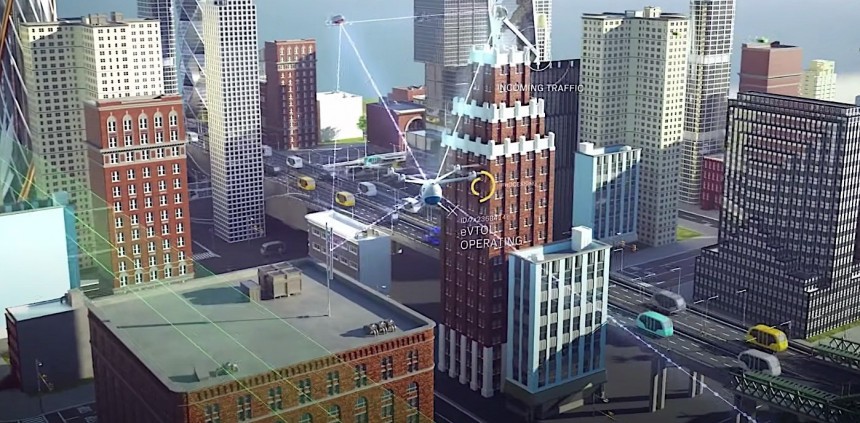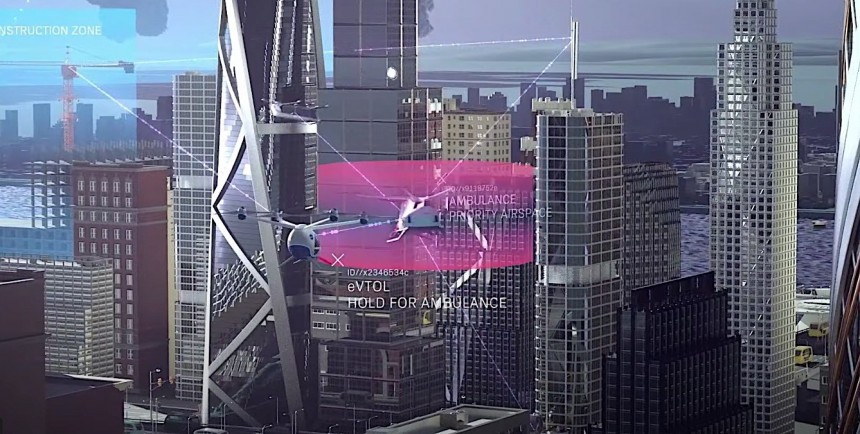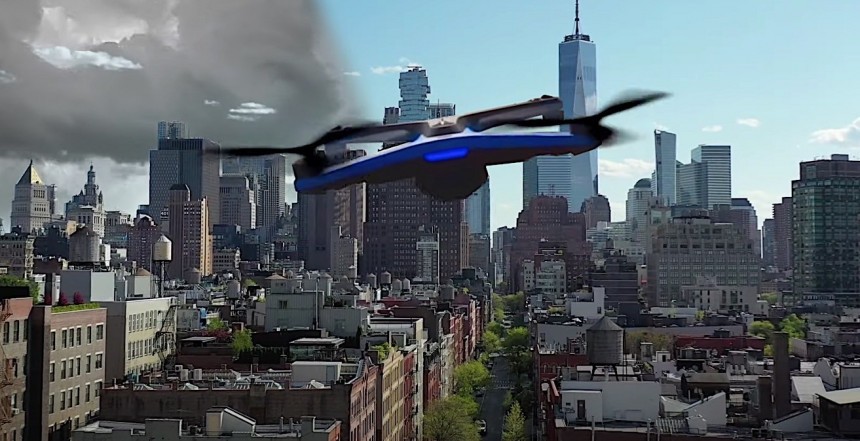Although it primarily is an agency dedicated to the advancement of the human race in space, NASA does from time to time stray from this mission and ventures into the world of aviation. It has done so several times in the past, and it’ll probably continue to be very much involved in our Earthly dealings for a long time to come. Especially now, when we’re on the verge of a massive evolutionary step dictated by the rise of autonomous VTOLS and drones.
NASA calls everything related to these things Advanced Air Mobility (AAM). It’s an umbrella term that comprises the drones and VTOLs themselves, the rules that will govern their operation, the logistics needed to safely keep them airborne, you name it.
As per NASA’s AAM vision, our mid-term future will look like something out of a sci-fi movie, with scores of self-flying machines delivering cargo and people to where they need to be. Air taxis, delivery drones, commuter VTOLs, and even airplanes as we know them today, all will fight for a piece of the city sky based on rules and technologies that are yet to be created.
The ecosystem needed to support AAM is perhaps the trickiest part of this future of ours. How do you keep a drone carrying a McDonald's menu from slamming into a flying taxi moving people to a party? How do you make autonomous VTOLs capable of avoiding bad weather, while still reaching their destination in time and safely? Can you use all these machines in places that are not within easy reach of regular aviation, with little to no ground support (including, thus, city centers)?
Those are only a few of the many questions that will have to be answered before air mobility of this kind becomes a reality. And thanks to NASA, that may happen sooner than anyone thinks.
Not long ago, the space agency announced it was working on something called Data & Reasoning Fabric (DRF). It’s not a product per se (yet), or a set of rules, but an ongoing project meant to see what it will take to give autonomous aircraft decision-making capabilities. An information infrastructure, if you will, that will put chaos in order.
A key element to that is of course access to information. Autonomous cars, such as they are today, make decisions based on a variety of technologies that help them detect what’s around them, weather conditions, and other aspects related to their driving. For them, it’s mostly a bi-dimensional world, where dangers can mostly occur from ground level, at speeds that are generally not blistering fast.
Because the realm of aircraft is a tridimensional one, and the speeds involved are much greater, car tech will probably not work as well up there. So, to get access to relevant information, aircraft will have not to rely on sensors and such, but rather to communicate with one another, but also with other parties.
It is exactly this information-sharing capability NASA is after with the DRF (the data aspect of the process). In the not-so-distant future, weather services, map providers, and all aircraft in a given airspace should be connected together in a single digital marketplace where all available info should be shared. Or a sort of collective brain, if you will.
The reasoning part of the DRF is what the autonomous aircraft should be capable of doing with that info. Just like navigation app Waze does when it decides to suggest a route change based on the info it receives from other sources, so should autonomous aircraft be capable of reacting and adapting to the info they receive, in real time.
To make it simpler to understand, consider this. Say you order takeout from your favorite restaurant, located some 10 miles (16 km) away. Drone delivery is offered by these guys, so you know the meal should be at your home in no time. On its way to you, a DRF-connected and enabled drone will be capable of taking a detour in case a storm forms on the initial flightpath, it will be aware of surrounding aerial traffic to avoid collisions, will give way to emergency drones, and so on.
All of the above might sound a bit futuristic, and something that needs to happen for autonomous air mobility to be safe, but it’s also something very real. At least in the sense that NASA has already begun testing the DRF concept.
Starting last month and going well into March 2023, the space agency is running a test of the technology required for this concept to work. It’s a digital test, of course, taking place above a simulated area of and around Phoenix, Arizona.
The tests are centered on several scenarios, including one that has a drone deliver medical supplies from the city’s center to the edge of the greater Phoenix region, and another that will have a drone take insulin to people in hard-to-reach areas. More mundane scenarios, such as re-routing an air taxi to avoid a sudden storm will also be simulated.
The main goals of the current procedures are to check how well the re-routing of the aircraft is handled when encountering a series of anomalies, including communication disruptions, unidentified drones in the flight path, and sudden changes in local weather conditions.
A separate test of the DRF was conducted with the California Civil Air Patrol, also in a simulated environment, and in this case, drones proved that when fed the proper information, they can “locate lightning-induced wildfires more quickly than usual.”
NASA, or more specifically the Ames Research Center, which is in charge of DRF research, does not say when we are to expect the first results of the tests, but this edge computing approach sure looks like something this nascent industry badly needs. What’s more important is the fact that whatever breakthroughs are made with the DRF will probably be suitable for other, more traditional means of transportation. Who knows, maybe this is the incipient stage of a truly smart city, complete with an equally smart airspace above it.
As per NASA’s AAM vision, our mid-term future will look like something out of a sci-fi movie, with scores of self-flying machines delivering cargo and people to where they need to be. Air taxis, delivery drones, commuter VTOLs, and even airplanes as we know them today, all will fight for a piece of the city sky based on rules and technologies that are yet to be created.
The ecosystem needed to support AAM is perhaps the trickiest part of this future of ours. How do you keep a drone carrying a McDonald's menu from slamming into a flying taxi moving people to a party? How do you make autonomous VTOLs capable of avoiding bad weather, while still reaching their destination in time and safely? Can you use all these machines in places that are not within easy reach of regular aviation, with little to no ground support (including, thus, city centers)?
Those are only a few of the many questions that will have to be answered before air mobility of this kind becomes a reality. And thanks to NASA, that may happen sooner than anyone thinks.
A key element to that is of course access to information. Autonomous cars, such as they are today, make decisions based on a variety of technologies that help them detect what’s around them, weather conditions, and other aspects related to their driving. For them, it’s mostly a bi-dimensional world, where dangers can mostly occur from ground level, at speeds that are generally not blistering fast.
Because the realm of aircraft is a tridimensional one, and the speeds involved are much greater, car tech will probably not work as well up there. So, to get access to relevant information, aircraft will have not to rely on sensors and such, but rather to communicate with one another, but also with other parties.
It is exactly this information-sharing capability NASA is after with the DRF (the data aspect of the process). In the not-so-distant future, weather services, map providers, and all aircraft in a given airspace should be connected together in a single digital marketplace where all available info should be shared. Or a sort of collective brain, if you will.
To make it simpler to understand, consider this. Say you order takeout from your favorite restaurant, located some 10 miles (16 km) away. Drone delivery is offered by these guys, so you know the meal should be at your home in no time. On its way to you, a DRF-connected and enabled drone will be capable of taking a detour in case a storm forms on the initial flightpath, it will be aware of surrounding aerial traffic to avoid collisions, will give way to emergency drones, and so on.
All of the above might sound a bit futuristic, and something that needs to happen for autonomous air mobility to be safe, but it’s also something very real. At least in the sense that NASA has already begun testing the DRF concept.
Starting last month and going well into March 2023, the space agency is running a test of the technology required for this concept to work. It’s a digital test, of course, taking place above a simulated area of and around Phoenix, Arizona.
The main goals of the current procedures are to check how well the re-routing of the aircraft is handled when encountering a series of anomalies, including communication disruptions, unidentified drones in the flight path, and sudden changes in local weather conditions.
A separate test of the DRF was conducted with the California Civil Air Patrol, also in a simulated environment, and in this case, drones proved that when fed the proper information, they can “locate lightning-induced wildfires more quickly than usual.”
NASA, or more specifically the Ames Research Center, which is in charge of DRF research, does not say when we are to expect the first results of the tests, but this edge computing approach sure looks like something this nascent industry badly needs. What’s more important is the fact that whatever breakthroughs are made with the DRF will probably be suitable for other, more traditional means of transportation. Who knows, maybe this is the incipient stage of a truly smart city, complete with an equally smart airspace above it.














